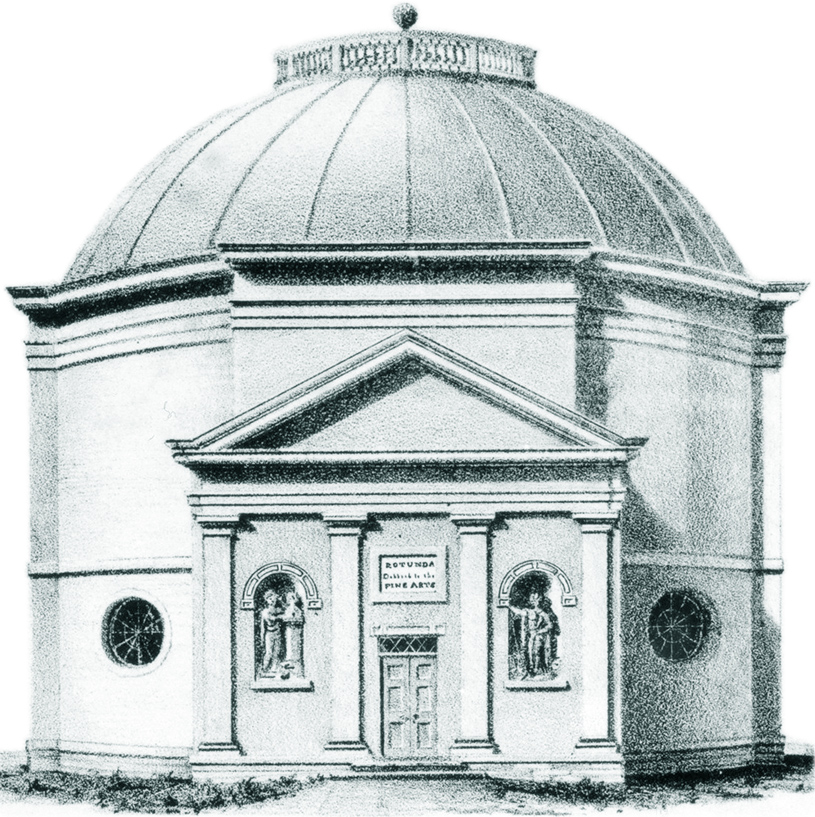
The Rotunda, City Hall Park
The Rotunda was erected in 1818 on the northeast corner of City Hall Park, near the corner of Chambers and Cross (now Center) streets, facing the park (there was a rotunda in the area since 1814 or before). It was built to house the John Vanderlyn's Panoramic View of the Palace and Gardens of Versailles, painted between 1818 and 1819. The City of New York leased the site to Vanderlyn for a symbolic payment, from March 1817 for nine years, then extended his lease through 1829. Donations from John Jacob Astor (1763-1848) and other wealthy New Yorkers helped fund the building. The Rotunda is widely regarded as the first art museum in New York City.
John Vanderlyn (1775–1852) was a renowned neoclassicist painter, born in Kingston, Province of New York. He was a protégé of Aaron Burr who in 1796 sent Vanderlyn to Paris, where he studied for five years. He was one of the founders of the National Academy of Design.
This brick structure design was inspired by the Pantheon in Rome. It had 56 feet in diameter, crowned with a thirty-foot dome and a central skylight. The Rotunda opened in 1818, when Vanderlyn's painting was unfinished. Other paintings were shown instead. Vanderlyn's panorama debuted in May 26, 1820, but ticket sales failed to cover his financial outlay, so it toured intermittently. Paintings by other artists were shown during those absences and, once Vanderlyn lost his lease in 1829, the building was used for a range of artistic and government functions.
Among the government functions, the Rotunda served the city as a criminal court (October 1829), a court of sessions (March-May 1830), a marine court (January 1831), a "Sessions Hall" for city government (January 1831) and a naturalization office (1834).
The Post Office moved to the Rotunda, after the Great Fire of 1835, destroyed the Merchants' Exchange, its former headquarters. On December 28, 1835, the Board of Aldermen adopted a resolution calling for the erection of an additional building adjoining the Rotunda for the accommodation of the Post Office. In February 1845, the Post Office moved to the premises of the old Middle Dutch Church at Nassau Street.
The Rotunda housed the New York Gallery of the Fine Arts, from July 1845 to June 1848. On July 24, that year, the Common Council notified the gallery to vacate the premises for the purpose of converting it into public offices. The refitted Rotunda housed, for example, the Croton Aqueduct Department, where the American Society of Civil Engineers was founded in 1852.
The Rotunda was demolished in 1870. Today, a bronze plaque, dedicated in 1981, marks the Rotunda's site in City Hall Park.

Panoramic View of the Palace and Gardens of Versailles by John Vanderlyn.
Repository: Metropolitan Museum of Art, New York, NY, originally displayed in the Rotunda.
The Rotunda, City Hall Park

|
Copyright © Geographic Guide - NYC in the 19th Century. |
Front elevation of the Rotunda. Illustration dated 1827, drawn on stone by Alexander Jackson Davis (1803-1892), published in Views of The Public Buildings in the City of New York [1826-1828] by Anthony Imbert.
